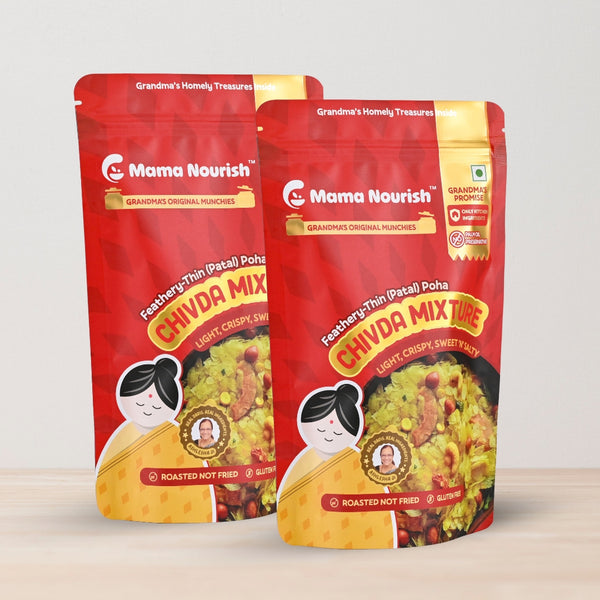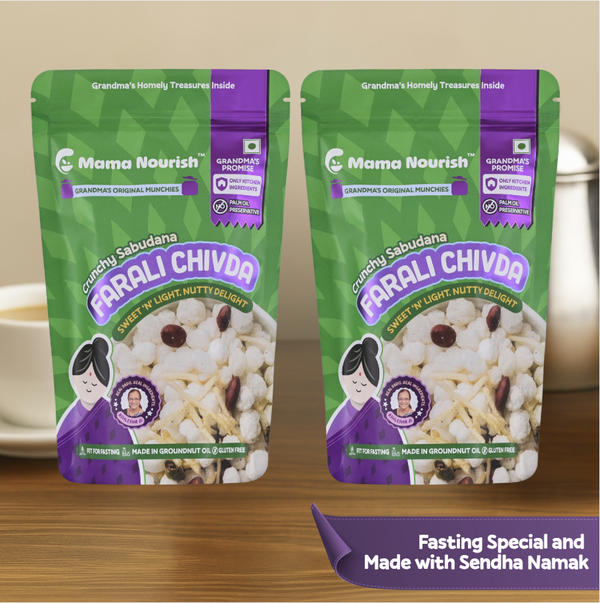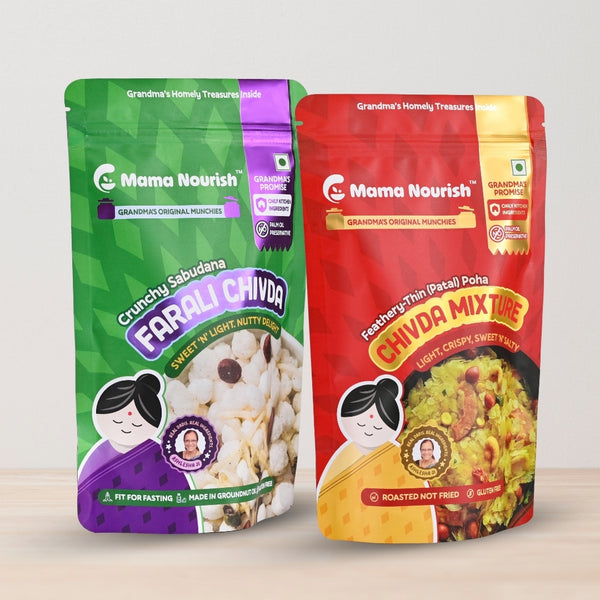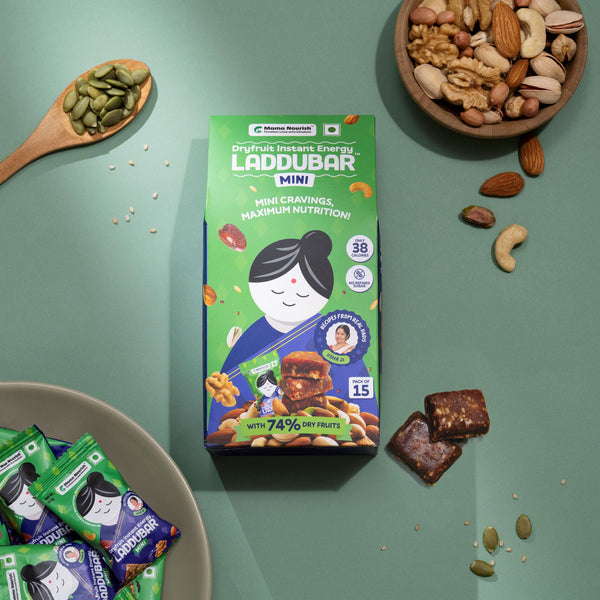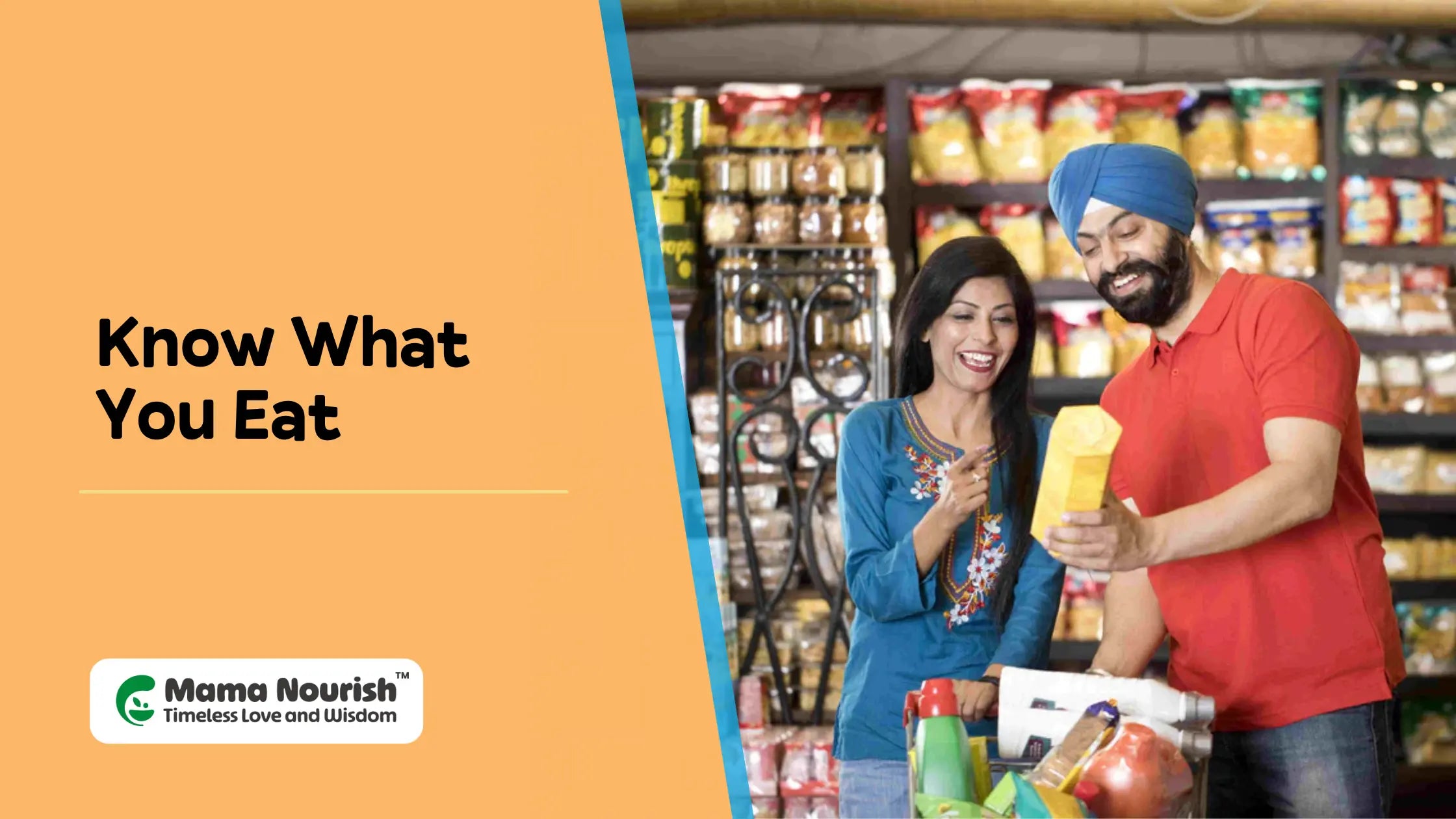
Know What You Eat
Understanding Food Labels: The Truth Behind Marketing Gimmicks!
When it comes to buying food – whether it's candies, snacks, ketchup, or breakfast cereals – what catches your eye first is the attractive, colourful image on the front cover!
Isn't it interesting that most of us are lured into buying foods with colourful images and popular claims like "No added sugar" or "No added preservatives" written in big letters? These claims seem so powerful that it's as if all foods marked with them automatically enter the realm of healthy food!
But have you ever looked closely at the back of those food packs? Did browsing through ingredients and nutrient facts ever really make any sense? It's intriguing - even though we fret about calories or blood sugar spikes, we often don't pay much attention to what we're actually eating.
Think about it – how keenly you check the features of a mobile phone or laptop before buying them. Yeah, we dig up every bit of information possible. But the irony is, we don't pay as much attention while buying what goes directly into our stomachs!
So, how about today we take a closer look at food labels to understand what we're eating?
Let's begin our journey by breaking down the ingredient list!-Yhea, let's attack the building blocks first!
1. Decoding the Ingredient List!

(WARNING: Many so-called "healthy" items in your pantry are about to reveal their true colours - be prepared.)
The first thing you should know when examining the ingredient list is that- Ingredients are listed in Descending order by Weight or Volume!
This means that the ingredients mentioned at the top are the major components of the food you eat. For example, if an ingredient list begins like this:
Ingredients: Refined wheat flour (maida), Sugar, Refined palm oil, Nuts, Fruits, Butter —
It means that the quantity of maida is the highest, followed by sugar, palm oil, etc. You will be surprised to find that the ingredient list of many so-called nutritious snacks actually has sugar as one of the major ingredients! Yes, the same sugar which is responsible for about 1.5 million deaths annually.
Additionally, the term "refined" is also not a good sign; it indicates that the ingredient is processed. Instead, look for "whole" ingredients.
While checking the ingredient list-What often baffles us is the length of the list and technical jargon. In fact, A lengthy list is usually a red flag - it means the food is highly processed.
1.1.Looking for Hidden Sugar…

“No added sugar" is one of the biggest selling points of numerous food items, but, does it mean your product is completely sugar-free? The answer is a big fat- No. Companies trick you by adding sugar in different forms like sugar alcohols, syrups, glucose, etc.
And the worst part is, some of them are worse than sugar! Take the case of maltodextrin; it has a high glycemic index of 85–105, way higher than sugar! The glycemic index indicates how fast a food item can raise your blood sugar level.
Another important thing is while scanning the list, look for artificial sugar substitutes - yes, your "No Added Sugar" product may contain artificial sweeteners more dangerous than sugar.
Common non-sugar sweeteners are acesulfame K, aspartame, advantame, cyclamates, neotame, saccharin, sucralose, stevia, and stevia derivatives.
Even the WHO has warned against them!
In fact, some sugar alternatives are more harmful to the body than sugar.
Studies have shown that artificial sweeteners were linked to a 9% higher risk of any type of cardiovascular problem (including heart attacks) and an 18% greater risk of stroke!
Here are some names to look for to find hidden Sugar content-

Pro -tip: Keep an eye out for ingredients ending in ‘-ose’ or ‘-tol’.
If you are looking for healthy, natural sugar alternatives explore-the-healthiest-sweetener-award-goes-to-dates-dates-vs-jaggery-vs-honey
1.2. Avoid Hidden Trans-fat and Look for Healthy Fat!

Trans fats are particularly harmful to health. The thing is- they raise bad cholesterol levels (LDL cholesterol) in the blood while lowering good cholesterol levels (HDL cholesterol), increasing the risk of heart disease, stroke, and type 2 diabetes.
Scrutinize ingredient lists for any mention of ingredients like "partially hydrogenated vegetable oil", ‘shortening’ and ‘margarine’
On the other hand, healthy fats such as monounsaturated fats (MUFA) and polyunsaturated fats (PUFA) play crucial roles in nutrient absorption, cell structure development, and brain health.

Here are some sources of healthy fat-

1.3. Salt Content

Consuming too much salt can lead to high blood pressure, raising the risk of various health issues like cardiovascular diseases, gastric cancer, obesity, osteoporosis, Meniere’s disease, and kidney disease.
The World Health Organization suggests that adults should aim for less than 2000 mg of sodium per day, which is equivalent to less than 5 grams of salt daily.
Here are some ingredients to watch out if you want to reduce your salt intake–

1.4. Watch out for Food additives and Preservatives
It's crucial to be cautious of preservatives commonly found in popular snacks and beverages, like sodium benzoate, potassium sorbate, and BHA.

While sodium benzoate and potassium sorbate are generally considered safe when used in small amounts, BHA has raised concerns in certain studies. Some side effects include- thyroid system damage, metabolic and growth disorders, neurotoxicity, and even cancer.
Pro tip: Additionally, ingredients with names ending in "-ate" or "-ite" are often preservatives.
Additionally, check for Artificial or permitted flavourings and colours,
Look for terms like "artificial flavours," "artificial colours," or specific names of additives such as "FD&C Yellow No. 5" or "sodium nitrite."
Class I preservatives, which are considered relatively safer and include substances like ascorbic acid (vitamin C) or tocopherols (vitamin E).
Key takeaways.
- Ingredients are listed in descending order by weight or volume, with longer lists often indicating highly processed foods.
- Watch out for harmful sugar substitutes and hidden trans fats like partially hydrogenated oils.
- Be mindful of salt content and avoid foods with excessive preservatives.
- Prioritize whole ingredients and minimize intake of processed foods for better health.
Now, let's move to the Nutrition facts.
2. Reading Nutrition Label

2.1. Pay Attention to Serving Size!
While checking the nutrition Label- Always check the serving size, which may be listed as either the number of servings per container or the weight/volume in grams/millilitres.
The Nutrition Facts are typically based on one serving per 100 grams or millilitres, but packages may contain more than one serving.
The companies may simply list the nutrition facts of one biscuit, one protein bar etc. But you may be consuming more than one biscuit a day, doubling the calories and nutrients listed.
The thing is- what matters is how much you actually consume per serving!
2.2 Daily Value (%DV)

You can see the daily value or DV listed on the right side of the nutrient facts. Well, this -% DV means what percentage of daily nutrient requirements a food fulfils, based on a 2000-calorie diet.
Remember a DV of 5% or less indicates low nutrient content, while 20% or more indicates high nutrient content.
So, keep these values in mind while checking all the nutrients!
2.3. Checking Nutrition Facts
1. Protein
Look for foods rich in proteins and fibre, essential for proper body function and digestive health.

Here is a list of some good sources of protein-
Fish (e.g., salmon, tuna, tilapia), Lean cuts of beef or pork, Eggs, Dairy products (e.g., Greek yoghurt, cottage cheese), Legumes (e.g., lentils, chickpeas, black beans), Tofu or tempeh, Nuts and seeds (e.g., almonds, walnuts, chia seeds).
2. Carbohydrate

The total carbohydrate on the label encompasses all three types-sugar, starch, and fibre. When counting carbs or selecting foods, it's crucial to consider the total grams.
Added Sugar
Checking for sugar content is a must-
Look for added sugar; try to avoid food with added sugar, but keep in mind no added sugar doesn't mean your food is sugar-free, as we discussed earlier.
3. Fats, Cholesterol
In a nutrition label, typically find the following types of fat listed-
Total Fat-The total amount of fat in the product, including all types of fat. We already discussed sources of healthy fats in the ingredient list. In addition to that, it's important to check the amount of saturated fat, MUFA, PUFA, and trans fat on the nutrition label.
Saturated Fat- it is the type of dietary fat found in animal products and some plant-based sources, solid at room temperature.
Consuming too much-saturated fat can raise levels of LDL (bad) cholesterol, increasing the risk of heart disease and stroke.
Monounsaturated fats (MUFA) and Polyunsaturated fats (PUFA)- They are considered healthy fats offering health benefits including lowering LDL cholesterol levels, reducing the risk of heart disease, and improving insulin sensitivity.
Trans Fat -is a type of fat that is formed when hydrogen is added to vegetable oil during a process called hydrogenation.
This procedure transforms liquid oils into solid fats, enhancing their stability and prolonging their shelf life. Trans fats are often found in processed and fried foods like fried chicken and french fries and baked goods like cakes and cookies.

According to the review study by Dhaka et al. (2011), trans fats pose significant health risks and exploring alternative approaches is crucial. The range of health issues caused include cardiovascular diseases, breast cancer, shortened pregnancy duration, increased risks of preeclampsia, nervous system and vision disorders in infants, colon cancer, diabetes, obesity, and allergies.
If a food contains partially hydrogenated oils, it still contains trans fats, even if the label states "0 grams of trans fats."
This is because manufacturers are allowed to round down to zero if the product contains less than 0.5 grams of trans fat per serving.
Therefore, it's important to check for partially hydrogenated oils in the ingredients list to avoid consuming trans fats.
4. Vitamins and Minerals
Choose foods rich in various vitamins and minerals to support overall health and immunity.
Don't forget to check the % DV value as mentioned above to find whether it's high or low.
5. Fiber
The fibre is generally good for the body as it helps improve digestion. Recommended fibre intake varies by age and gender, with healthy adults needing 25 to 38 grams daily.

6. Sodium
The World Health Organization suggests that adults should aim for less than 2000 mg of sodium per day, which is equivalent to less than 5 grams of salt daily. It's essential to be mindful of our sodium intake to maintain good health.
Reading Nutrition Labeling- Key Takeaways
- Be mindful of serving sizes listed on nutrition labels, as they can impact your total calorie and nutrient intake.
- Pay attention to the Daily Value (%DV) to gauge the nutrient content of foods, aiming for a lower %DV for unhealthy nutrients and a higher %DV for beneficial ones.
- When checking nutrition facts, focus on limiting the intake of fats, sodium, and added sugars while prioritizing foods rich in fibre, vitamins, minerals, and protein.
Finally, let's look into commonly used claims and what it means-
3. Demystifying Common Food Claims


Making an Informed Choice...
In this article, we attempted to decode food labelling to understand the true nutritional quality of our food. We hope that this valuable information empowers you to make informed, healthy choices.
Share

